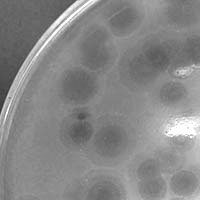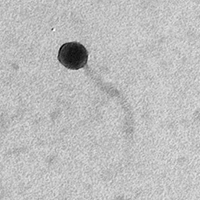Mycobacterium phage Scopus17
Know something about this phage that we don't? Modify its data.
| Detailed Information for Phage Scopus17 | |
| Discovery Information | |
| Isolation Host | Mycobacterium smegmatis mc²155 |
| Found By | Young (Glory) Kim |
| Year Found | 2013 |
| Location Found | Yorktown, VA USA |
| Finding Institution | Trinity College |
| Program | Science Education Alliance-Phage Hunters Advancing Genomics and Evolutionary Science |
| From enriched soil sample? | Yes |
| Isolation Temperature | Not entered |
| GPS Coordinates | 37.133447 N, 76.443333 W Map |
| Discovery Notes | The moisture in the soil is moderate. No water may be squeezed from the sample, but the texture is moist. The soil is collected from about 5 cm below the surface. The area from which the soil was collected is shaded by tall trees above. The habitat is the woods; however, there is an estuary and a wetland environment with mud nearby. The wetland is the Chesapeake Bay Coastal river basin in Virginia. The general area is also shaded by large trees a majority of the time. These larger trees include: Quercus palustris (pin oak), Platanus occidentalis (sycamore), Acer saccharinum (silver maple), and Acer rubrum (red maple). Some of the plants around the sampled area include: Hedera helix (common ivy), Leersia virginica (white cutgrass), Arthraxon hispidus (jointhead arthraxon), Microstegium vimineum (Japanese stilt grass), Boehmeria cylindrica (false nettle), and Toxicodendron radicans (poison ivy). |
| Naming Notes | "Scopus" means "target" in Latin. The name indicates the plaque morphology which resembles a target with multiple rings. There were 17 students in my class who participated in the research program. The similarity to the word to "microscopy" and the definition of the word "scope" was also considered. |
| Sequencing Information | |
| Sequencing Complete? | No |
| Genome length (bp) | Unknown |
| Character of genome ends | Unknown |
| Fasta file available? | No |
| Characterization | |
| Cluster | Unclustered |
| Subcluster | -- |
| Annotating Institution | Unknown or unassigned |
| Annotation Status | Not sequenced |
| Plaque Notes | Possibly partially lysogenic – bull’s eye plaques with up to five “rings." After 24 hours, plaques are clear and exhibit 1-2 “halos” about 0.4 cm in diameter. After 48 hours, multiple rings appear, diameter increases to 0.8 cm. |
| Has been Phamerated? | No |
| Publication Info | |
| Uploaded to GenBank? | No |
| GenBank Accession | None yet |
| Refseq Number | None yet |
| Archiving Info | |
| Archiving status | Archived |
| Pitt Freezer Box# | 2 |
| Pitt Freezer Box Grid# | G1 |
| Available Files | |
| Plaque Picture | Download |
| Restriction Digest Picture | Download |
| EM Picture | Download |

